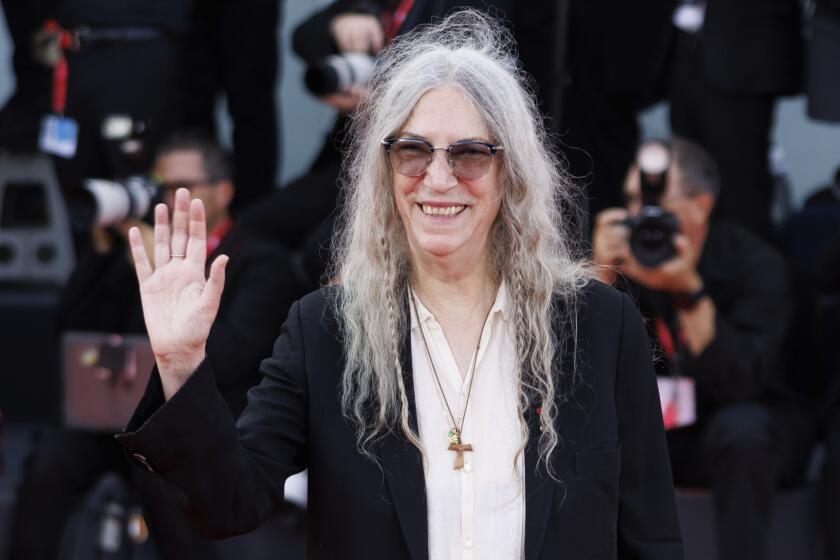JAZZ REVIEW : Joey Sellers’ Re-Creative Processes : The inventive trombonist constructs a new role for his instrument by stripping tunes to the bones, then reassembling them in his own image.
- Share via
LONG BEACH — Trombonist Joey Sellers is ready to dismantle jazz. The deconstructive approach to “If I Only Had a Brain” aired by his quartet Monday at System M turned the quaint, little ditty from “The Wizard of Oz” into a declaration of freedom, one that went on for nearly 20 minutes.
Sellers, along with fellow trombonist Michael Vlatkovich (who was leading his quintet this same night at Santa Monica’s Alligator Lounge), is constructing a new role for his instrument.
A past winner of the Gil Evans Fellowship in Jazz Composition, the trombonist likes to strip tunes to the bare bones, then reassemble them in his own image. As he explained between sets, this means “stretching the rhythm,” turning the tempo inside out in such a way that soloists are forced to bring something different to what might otherwise be the same old song and dance.
Central to carrying out this concept is Sellers’ drummer, Billy Mintz, a man who seemingly does everything in his power to avoid playing on the beat. Mintz, a master of shading and color, stirs tunes gently with his brushes, or rattles them with off-step snare and tom-tom exchanges.
His delicately struck tempos are spare, airy affairs in which cymbals play only a minor role. Like fellow drummer Paul Motian, his rhythmic treatments are an acquired taste. But once understood, it’s hard to hear the drums played any other way.
Without a piano, Sellers’ combo relies heavily on the bassist for harmonic support, and the trombonist has a knack for employing the best. When his longtime associate Ken Filiano moved east, Sellers brought in upright master Michael Formanek from New York for his group’s featured appearance at the Alligator Lounge’s “New Music Mondays” series in October.
This time, Sellers’ current bassist, Trey Henry, was with Vlatkovitch in Santa Monica, so the trombonist sought out Orange County resident Art Davis to fill the bill. It was a wise choice.
*
Davis, who’s worked with the likes of Max Roach, Dizzy Gillespie and the New York Philharmonic, has plenty of “free jazz” experience, having recorded with John Coltrane on the tenor titan’s landmark, avant-garde experiment “Ascension.”
Add tenor saxophonist Tony Malaby, who spent time with the Mingus Big Band Workshop, the repertory ensemble that has for the last few years played weekly at Greenwich Village’s Time Cafe, and you have a team as varied in personality as the crew of the Starship Enterprise.
The quartet opened with a skewered version of Cole Porter’s “I Love You” that found Sellers and Malaby exchanging lines before joining with Davis and Mintz to hint at the familiar theme.
Davis’ spare, low-end support was decorated with higher-pitched details placed between the horn players’ lines, then sped ahead as the trombonist moved into his solo. Malaby followed with short, pointed statements that gave way to a swinging passage that he handled assertively, while the trombonist added ascending phrases in support.
The bassist’s solo balanced melodic passages against bursts of notes in the upper register. Then Mintz, stroking his kit deliberately with the brushes, painted a backdrop in which time seemed to stand still.
Malaby’s “Cosas” featured strong interplay between the saxophonist and his trombone-wielding boss. “Mesopotamian Love God” was a bluesy march that featured Davis’ bowed, Mingus-minded solo.
But it was “If I Only Had a Brain” that best revealed the madness behind Sellers’ method. The trombonist used one line from the familiar lyric as a touchstone as he wandered far from home.
Sellers isn’t one to bluster on the slide. Instead his playing is surprisingly melodic, though skewered against the rhythm. At times his attack resembled the art that hung from the System M walls: cartoonish figures in dangerous predicaments superimposed over classical landscapes.
Malaby’s playing also carried a confident lyricism, while ranging far and wide from a number’s melody. He seemed especially adept at moving from confused, cacophonous phrases into ones of great beauty.
The combo took Lee Konitz’s bop-meets-free-jazz exercise “Subconscious Lee” into the outer realms with Malaby’s anxious tenor improvisation leading the way.
The tune was proof that Sellers’ ensemble is a vital one that deserves to be heard more frequently. (Sellers also leads a nine-piece ensemble that has recorded two excellent CDs for the adventurous 9 Winds label, but that group hasn’t played Southern California since an appearance at El Matador in Huntington Beach some three years ago.)
Booking this kind of music into the current, conservative club scene takes a bit of nerve if not artistic commitment. More clubs should follow System M’s lead.
More to Read
The biggest entertainment stories
Get our big stories about Hollywood, film, television, music, arts, culture and more right in your inbox as soon as they publish.
You may occasionally receive promotional content from the Los Angeles Times.










